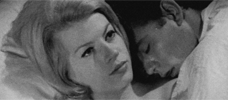Reviews
Russ Meyer
USA, 1975
Credits
Review by David Carter
Posted on 09 September 2008
Source RM Films International VHS
Categories Bosomania!: The Sex, the Violence, and the Vocabulary of Russ Meyer
After experimenting with studio filmmaking and period drama, Russ Meyer returned to the type of film for which he is best known with Supervixens!. A short but uncharacteristic three-year gap separated it from his previous film, Black Snake, but there are enormous differences between the two. Black Snake departed, in form and tone, from Meyer’s previous films, but Supervixens! reveled in their influence; each scene brims with familiar allusions and familiar faces. It was a reinstatement of purpose for Meyer, a return to the world of big bosoms and square jaws. It is more than just business as usual, however. As the title implies, Supervixens! is an explosion of all things Meyer—visually and thematically.
Handsome everyman Clint Ramsey works at fugitive Nazi Martin Bormann’s gas station. In a repeat of what is said to be a frequent episode, his insatiable girlfriend SuperAngel is on the phone demanding that he come home immediately for sex. Clint refuses at first, as he’s distracted by the impossibly busty SuperLorna’s advances. He eventually sends her away frustrated to return to SuperAngel who accuses him of infidelity. Their bickering turns into a violent fight with Clint on the losing end. A concerned neighbor calls the police and officer Harry Sledge arrives, knocks Clint unconscious, and takes Angel to the hospital. Harry returns to see SuperAngel later that day, but his impotence infuriates her. Humiliated and frustrated, Harry attacks her while she hurls insults at him, accidentally killing her in the process. He then frames Clint for her murder, forcing the young man to go on the lam.
Clint meets various characters in his Homeric journey west before ultimately finding redemption in the arms of SuperVixen, a doppelgänger for SuperAngel but the binary opposite of her in regards to personality. In SuperVixen, Clint finds the happy relationship he has been searching for but again things are spoiled by the reappearance of Harry Sledge. Clint displays an inconceivable amount of naïveté by not recognizing Harry or realizing the threat he poses, instead befriending him and introducing him to SuperVixen. As the spirit of SuperAngel looks on from above, Harry kidnaps SuperVixen to lure Clint into a trap.
Meyer’s frenetic editing seamlessly fuses together locations and dialogue into a continuous montage. In the opening sequence images last a mere five seconds at the longest before abruptly changing, giving the effect similar to a slideshow of still images rather than a motion picture. It isn’t disorienting, however; the effect gives the film a momentous rhythm that is carried through all later action. When Meyer eventually does pan the camera it is only to follow Clint, clearly marking him as the focus of the film and highlighting his dynamic nature among a world populated by static archetypes.
The journey Clint sets out on is the central plot, and it works on two distinct levels. Superficially it is a quest for freedom, both legally and sexually. As Clint tries to escape prosecution for Angel’s murder, he encounters three women - SuperCherry, SuperSoul, and SuperEula - who are only interested in sleeping with him. Two of the three mirror Angel’s actions and unsuccessfully attempt to rape him. Clint refuses each woman, however—something that goes against the typical misogynistic fantasy indulgence one usually finds in sexploitation cinema. His internal journey is not for freedom or sex, but for love. When he settles down with SuperVixen, it is Meyer’s implication that out of all of the women he has met she is the most desirable. Going against expectations, SuperVixen is the least sexual of all of the women in the film and her importance is reiterated when Meyer allows her and Clint to have one of the rare instances of uninterrupted sex in his work, albeit off screen. In doing so he allows her the illusion of remaining somewhat modest and chaste—at least in Meyer terms. The absence of a raw, Meyerian sexuality is SuperVixen’s virtue and Meyer guides both Clint and the audience to desire her for that reason.
Harry’s attacks on SuperAngel and SuperVixen are two of the most violent and disturbing scenes in any Meyer film. The first in particular is quite sadistic - something more akin to a grindhouse roughie than to a sexploitation film - with a maniacal Charles Napier threatening Angel through his wide smile before killing her in a bathtub full of blood. Violence and the threat of violence become recurring motifs in the rest of the film. It should be noted that violence and sex are kept as separate entities for the most part. Rather than a sexualized violence, violence is depicted as the end of sexuality—a negative force overtaking a positive one.
In Harry’s final assault on SuperVixen and Clint, he inexplicably but very importantly appears in a different outfit at one point. His regular jeans and t-shirt are replaced with a more formal khaki jumpsuit and black beret. Meyer has clothed Harry in the stereotypical garb of a film director, thus revealing Harry’s purpose in the film. Harry/the director only shows up to complicate Clint’s life, to literally and figuratively throw dynamite in his path to SuperVixen’s redemptive love. In these final scenes it is quite obvious that it is Harry who is responsible for everything that has happened to Clint, which serves the dual purpose of further vilifying him to the audience and absolving Clint and the female characters of any responsibility.
It bears noting that Harry not only resembles a stereotypical movie director; he also resembles two specific directors as well. First, his outfit evokes images of scenes from Loony Toons cartoons where Bugs Bunny or Daffy Duck would put on the garb of a director. It is not coincidental then that these final scenes are accompanied by rollicking piano in the Loony Toons vein; Meyer’s living cartoon motif is quite evident, ending Harry’s assault with the Road Runner’s “Beep Beep.” More importantly though, Harry looks uncannily like Meyer himself, revealing the true mastermind behind the film’s events.
Some have pointed to Supervixens! as the quintessential Meyer film because it embodies so many of the characteristics of his work. Indeed, Googling “Russ Meyer” returns more images of SuperLorna and the Supervixens! poster than images of the man himself or any of his other stars or films. It lacks the forward-looking momentum of Meyer’s previous work and reprises his familiar devices, expanding but not adding anything to them. Supervixens! is ultimately a reflective film, Russ Meyer’s homage to Russ Meyer, more a “greatest hits” package than new material.
More Bosomania!: The Sex, the Violence, and the Vocabulary of Russ Meyer
-

The Immoral Mr. Teas / Eve and the Handyman
1959 / 1961 -

Lorna
1964 -

Fanny Hill
1964 -

Mudhoney
1965 -

Faster, Pussycat! Kill! Kill!
1965 -

Motor Psycho
1965 -

Mondo Topless
1966 -

Common-Law Cabin
1967 -

Good Morning and… Goodbye!
1967 -

Finders Keepers, Lovers Weepers!
1968 -

Vixen!
1968 -

Cherry, Harry & Raquel!
1970 -

Beyond the Valley of the Dolls
1970 -

The Seven Minutes
1971 -

Black Snake
1973 -

Supervixens!
1975 -

Up!
1976 -

Beneath the Valley of the Ultravixens
1979
We don’t do comments anymore, but you may contact us here or find us on Twitter or Facebook.



